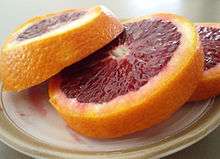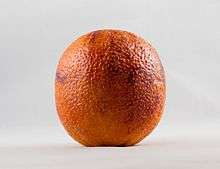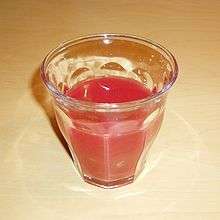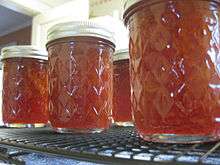Blood orange
| Blood orange | |
|---|---|
 A sliced blood orange | |
| Species | Citrus × sinensis |
| Cultivar group | Blood orange cultivars |
| Origin | China or the Southern Mediterranean, 18th Century |
| Cultivar group members | |
The blood orange is a variety of orange (Citrus × sinensis) with crimson, almost blood-colored flesh.
The distinctive dark flesh color is due to the presence of anthocyanins, a family of antioxidant pigments common to many flowers and fruit, but uncommon in citrus fruits.[1] Chrysanthemin (cyanidin 3-O-glucoside) is the main compound found in red oranges.[2] The flesh develops its characteristic maroon color when the fruit develops with low temperatures during the night.[3] Sometimes, dark coloring is seen on the exterior of the rind, as well, depending on the variety of blood orange. The skin can be tougher and harder to peel than that of other oranges. Blood oranges have a unique flavor profile compared to other oranges, being distinctly raspberry-like in addition to the usual citrus notes.[3]

The blood orange is a natural mutation of the orange, which is itself a hybrid, probably between the pomelo and the tangerine,[4] Within Europe, the arancia rossa di Sicilia (red orange of Sicily) has Protected Geographical Status.[5] In the Land of Valencia, it was introduced in the second half of the 19th century.[6]
Cultivars
The three most common types of blood oranges are the 'Tarocco' (native to Italy), the 'Sanguinello' (native to Spain), and the 'Moro', the newest variety of the three.[7][8] Other less common types include 'Maltese', 'Khanpur', 'Washington Sanguine', 'Ruby Blood', 'Sanguina Doble Fina', 'Delfino', 'Red Valencia', 'Burris Blood Valencia', 'Vaccaro', 'Sanguine grosse ronde', 'Entre Fina', and 'Sanguinello a pignu'. The 'Maltese' is known to be the sweetest.[9] While also pigmented, Cara cara navels and Vainiglia Sanguignos have pigmentation based on lycopene, not anthocyanins like blood oranges.[7]
Moro
The 'Moro' is the most colorful of the blood oranges, with a deep red flesh and a rind with a bright red blush.[10] The flavor is stronger and the aroma is more intense than a normal orange. This fruit has a distinct, sweet flavor with a hint of raspberry.[11] This orange is more bitter than the 'Tarocco' or the 'Sanguinello'. The 'Moro' variety is believed to have originated at the beginning of the 19th century in the citrus-growing area around Lentini (in the Province of Siracusa in Sicily)[12][13] as a bud mutation[14] of the "Sanguinello Moscato".[7] The 'Moro' is a "deep blood orange",[7] meaning that the flesh ranges from orange-veined with ruby coloration, to vermilion, to vivid crimson, to nearly black.
Tarocco

The name 'Tarocco' is thought to be derived from an exclamation of wonder expressed by the farmer who was shown this fruit by its discoverer. It is a medium-sized fruit and is perhaps the sweetest and most flavorful of the three types. The most popular table orange in Italy, it is thought to have derived from a mutation of the 'Sanguinello'. It is referred to as "half-blood", because the flesh is not accentuated in red pigmentation as much as with the 'Moro' and 'Sanguinello' varieties. It has thin orange skin, slightly blushed in red tones. The 'Tarocco' is one of the world's most popular oranges because of its sweetness (Brix to acid ratio is generally above 12.0) and juiciness. It has the highest vitamin C content of any orange variety grown in the world, mainly on account of the fertile soil surrounding Mount Etna, and it is easy to peel. The 'Tarocco' orange is seedless.
The University of California, Riverside Citrus Variety Collection has delineated three subcultivars of 'Tarocco'. The 'Bream Tarocco', which was originally donated by Robert Bream of Lindsay, California, is of medium to large fruit with few to no seeds. 'Tarocco #7', or 'CRC 3596 Tarocco', is known for its flavor, but has a rind with little to no coloration. The 'Thermal Tarocco' was donated by A. Newcomb of Thermal Plaza Nursery in Thermal, California.
Sanguinello

The 'Sanguinello' /sæŋɡwᵻˈnɛloʊ/, also called 'Sanguinelli' in the US (the plural form of its name in Italian), discovered in Spain in 1929, has a reddish skin, few seeds, and a sweet and tender flesh. 'Sanguinello', the Sicilian late "full-blood" orange, is close in characteristics to the 'Moro'. Where grown in the Northern Hemisphere, it matures in February, but can remain on trees unharvested until April. Fruit can last until the end of May. The peel is compact, and clear yellow with a red tinge. The flesh is orange with multiple blood-colored streaks.
History and background


Blood oranges may have originated in either China or the southern Mediterranean, where they have been grown since the 18th century. They are now the primary orange grown in Italy. The anthocyanins which give the orange its distinct maroon color will only develop when temperatures are low at night, as during the Mediterranean fall and winter.[3] Blood oranges cultivated in the United States are in season from December to March (Texas), and from November to May (California).[15]
As a food
Blood oranges' red pigment anthocyanin is an antioxidant.[1] The pigments begin accumulating in the vesicles at the edges of the segments and at the blossom end of the fruit, and continue accumulating in cold storage after harvest. Due to its pigments, the blood orange contain greater amounts of antioxidants than other oranges.
Some blood orange juice may be somewhat tart, while other kinds are sweet while retaining the characteristic blood orange taste. The oranges can also be used to create marmalade, and the zest can be used for baking.[16][17] A popular Sicilian winter salad is made with sliced blood oranges, sliced bulb fennel, and olive oil.[18] The oranges have also been used to create gelato, sorbet, and Italian soda.[19][20][21] Blood oranges are also popular in vinaigrette-style dressings, and are sometimes used to flavor niche-market beer.[22][23]
Blood oranges are a source of vitamin C like all citrus fruits. A medium-sized (154-g) orange also provides 28% of the recommended daily intake of dietary fiber. Oranges can also be a valuable source of folate, calcium, and thiamine.[24]
The juice of the 'Moro', rich in anthocyanins, improved fatty liver in mice. 'Moro' juice counteracts liver steatogenesis in mice with diet-induced obesity, thus may represent a promising dietary option for the prevention of fatty liver.[25]
References
- 1 2 Paolo, Rapisarda; Fabiana, Fanella; Emanuele, Maccarone (2000). "Reliability of Analytical Methods for Determining Anthocyanins in Blood Orange Juices". J. Agr. Food Chem. 48 (6): 2249–2252. PMID 10888531. doi:10.1021/jf991157h.
- ↑ Felgines, C.; Texier, O.; Besson, C.; Vitaglione, P; Lamaison, J.-L.; Fogliano, V.; Scalbert, A.; Vanella, L.; Galvano, F. (2008). "Influence of glucose on cyanidin 3-glucoside absorption in rats". Mol. Nutr. Food Res. 52 (8): 959–964. PMID 18646002. doi:10.1002/mnfr.200700377.
- 1 2 3 McGee, Harold (2004). On food and cooking: the science and lore of the kitchen. New York: Scribner. pp. 376. ISBN 0-684-80001-2.
- ↑ Nicolosi, E.; Deng, Z. N.; Gentile, A.; La Malfa, S.; Continella, G.; Tribulato, E. (2000). "Citrus phylogeny and genetic origin of important species as investigated by molecular markers". Theor. Appl. Genet. 100: 1155–1166. doi:10.1007/s001220051419.
- ↑ "IGP Arancia Rossa di Sicilia: Territory". IGP Arancia Rossa di Sicilia. Archived from the original on 2011-07-22. Retrieved 2010-12-28.
- ↑ Besó Ros, Adrià (2016). Horts de tarongers. La formació del verger valencià (in Valencian). Valencia: Institució Alfons el Magnànim. p. 144. ISBN 978-84-7822-686-3.
- 1 2 3 4 Reuther, Walter; Batchelor, Leon Dexter; Webber, Herbert John (January 1967). "Horticultural Varieties of Citrus". Citrus Industry: Crop Protection. Volume I: History, World Distribution, Botany, and Varieties (Rev. ed.). University of California. ISBN 0-931876-24-9.
- ↑ Russo, Susan (January 28, 2009). "Blood Oranges: Change You Can Believe In". Kitchen Window. National Public Radio.
- ↑ Siebert, T. "Blood oranges". Center for Visual Computing. Retrieved 2010-12-28.
- ↑ Adams, William D.; Carol Brouwer; Ethan Natelson; Robert A. Randall (2006). Recommended Fruit and Nut Varieties: Harris County and Vicinity (PDF) (Report). Texas AgriLife Extension Service.
- ↑ "Types of Oranges – Blood, Navel, Valencia". Sunkist Growers, Incorporated. Retrieved May 20, 2010.
- ↑ "Orange Varieties". Innvista. Archived from the original on 2010-12-05. Retrieved 2011-01-10.
- ↑ "Pigmented Oranges". VioVi. Retrieved 2011-01-10.
- ↑ "Bud mutations in persimmon". HortNET. Archived from the original on 29 September 2011.
- ↑ "Gourmet Sleuth: Blood Oranges". Gourmet Sleuth. Retrieved 2011-01-10.
- ↑ McClellan, Marisa. "Blood Orange Marmalade". Food In Jars. Retrieved 2011-01-12.
- ↑ Jones, Jessica. "Blood Orange Scones". Jonesing For. Retrieved 2011-01-12.
- ↑ "Il Forno: A winter salad: Sicilian Fennel and Orange Salad". typead. Retrieved 2011-01-10.
- ↑ "Blood Orange Gelato". Martha Stewart. Retrieved 2011-01-10.
- ↑ "Blood Orange Sorbet Recipe". Epicurious. Retrieved 2011-01-10.
- ↑ "Wegmans Frizzante European Soda, Blood Orange". Wegmans. Retrieved 2011-01-10.
- ↑ "Blood Orange Vinaigrette Recipe". About.com. Retrieved 2011-01-10.
- ↑ "Homebrewing Blood Orange Hefeweizen". Beer 47. Retrieved 2011-01-10.
- ↑ "Blood Orange". P-O-P Interactive, Inc. Archived from the original on 2011-03-15. Retrieved 2010-12-28.
- ↑ Salamone, Federico; Li Volti, Giovanni; Titta, Lucilla; Puzzo, Lidia; Barbagallo, Ignazio; La Delia, Francesco; Zelber-Sagi, Shira; Malaguarnera, Michele; Pelicci, Pier Giuseppe; Giorgio, Marco; Galvano, Fabio (2012). "Moro orange juice prevents fatty liver in mice". World J. Gastroenterol. 18 (29): 3862–3868. PMC 3413058
 . PMID 22876038. doi:10.3748/wjg.v18.i29.3862.
. PMID 22876038. doi:10.3748/wjg.v18.i29.3862.
External links
| Wikimedia Commons has media related to Blood oranges. |
- Blood Oranges Information
- Ortogel Sicilian Blood Orange
- Gourmet Sleuth
- Red Orange of Sicily PGI official site